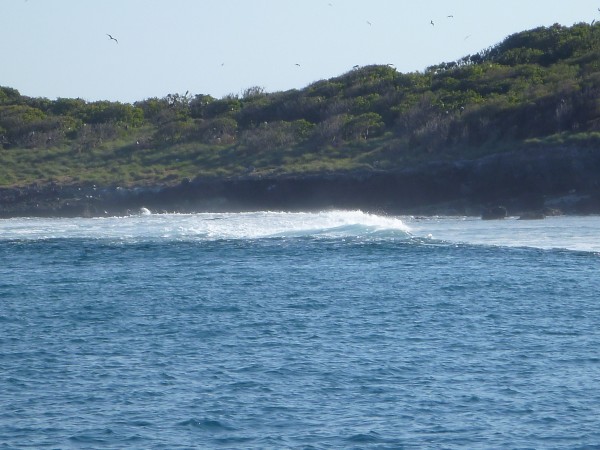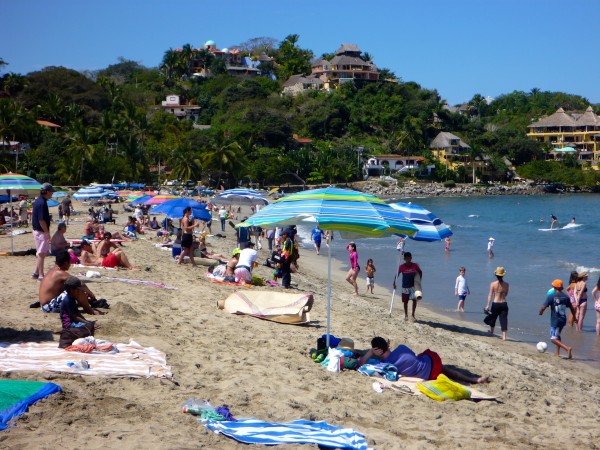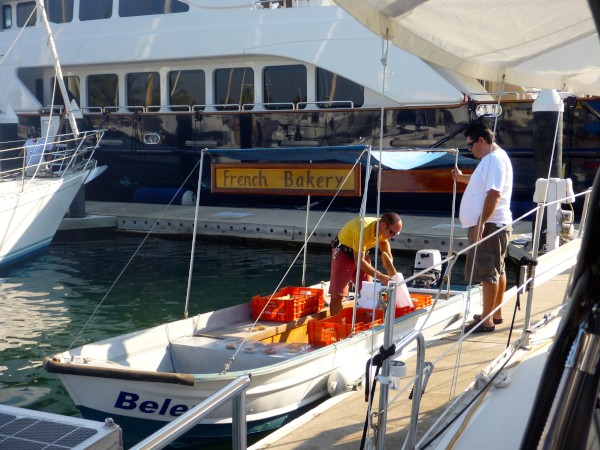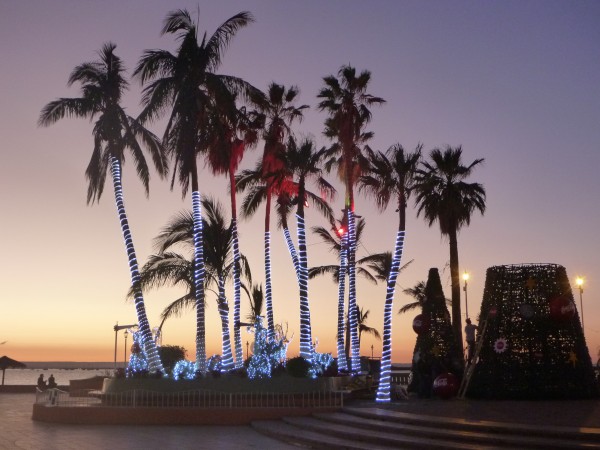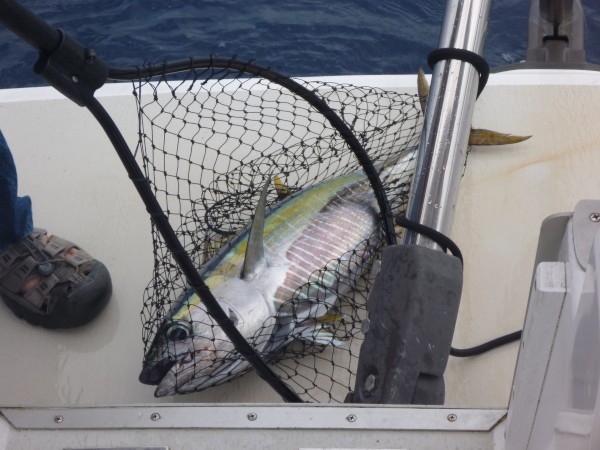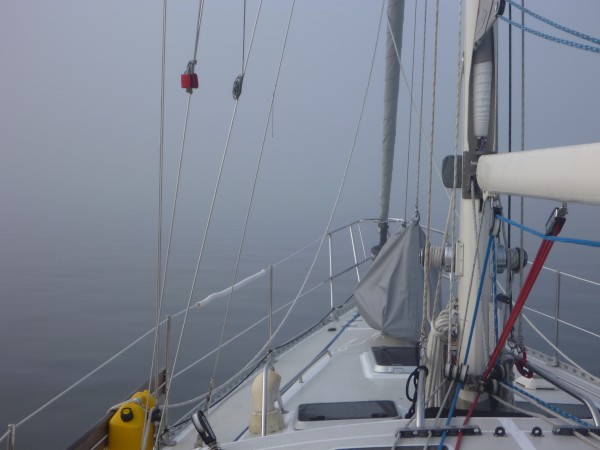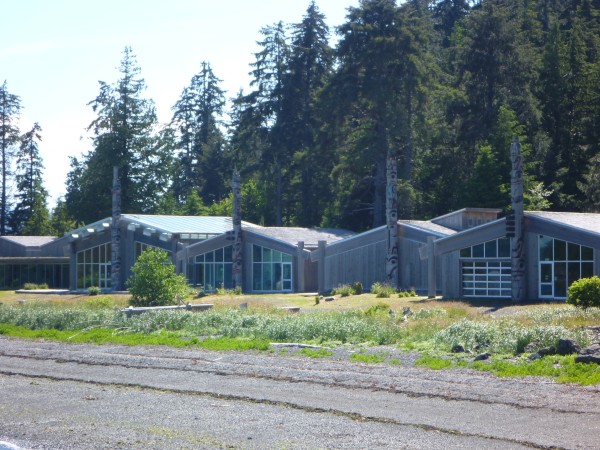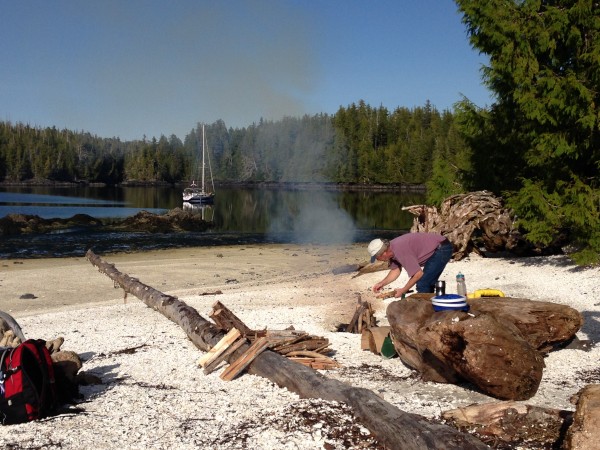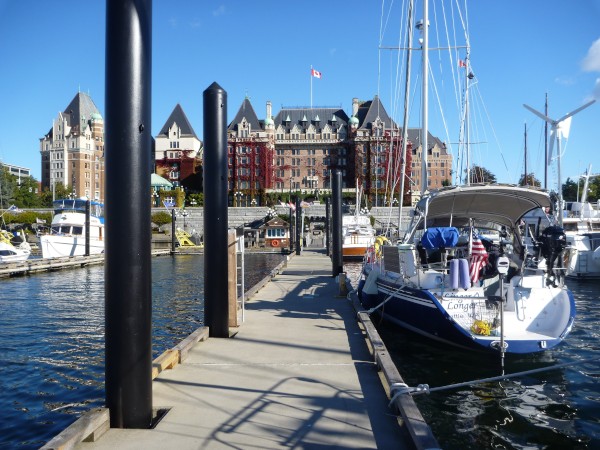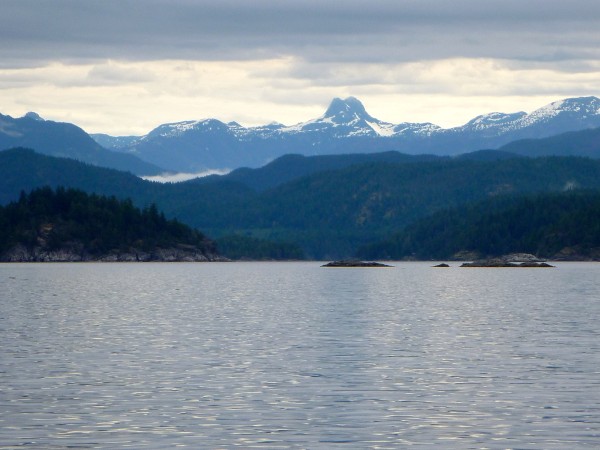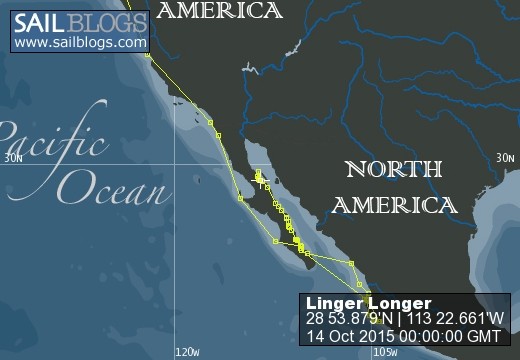
Linger Longer
14 September 2016
06 August 2016
09 July 2016
19 March 2016
19 December 2015
18 December 2015
18 December 2015
03 November 2015
18 July 2015
24 May 2015
04 April 2015
31 March 2015
26 February 2015
15 February 2015 | Barra de Navidad
07 February 2015 | Tenacatita Bay
04 February 2015
26 January 2015 | 19 18.051'N
04 January 2015 | La Cruz, Nayarit, Mexico
25 December 2014 | La Paz, Baja California Sur, Mexico
01 December 2014 | Ensenada, Mexico
Reflections by Kirk
26 February 2015

I am SO confused. It just seems natural to be able to determine which place has been our favorite so far. Just cannot do this. I have written a bit about Barra de Navidad and Bahia Tenacatita and how terrific they both were. Now we are back in Banderas Bay in La Cruz and it is at least equally terrific, but in maybe different ways. Both Barra de Navidad and Bahia Tenacatita had wonderful in-the-water and on-the-beach opportunities. La Cruz, not so much about in-the-water, but the activities available to us are outstanding. The music scene here is quite good, with most nights offering multiple opportunities to listen to live music. Banderas Bay also seems to be the primary gathering place for people preparing to do the "Pacific Puddle Jump," making the crossing of the huge Pacific Ocean to the South Pacific. A side benefit for Kris and me are the multitude of seminars on subjects related to ocean cruising. Folks who have seen and done it give these seminars.
Let me describe our first full day back here in La Cruz. We woke up with the sun, which is not until about 7:15, made a cup of coffee, and read for a little while. About 9:30 we walked for about ten blocks to Jardin de Pulpa (Octopus's Garden) to have a little more excellent coffee and a cinnamon bun. This is a very cool place. You walk through the entry and enter a lush open-air courtyard. The tables are scattered around on a brick floor, with in-ground potted trees and shrubs towering above. In the back is the Huichol Indian art gallery, very intricate and colorful creations of either yarn or beads. About 10:15 we go up the brick stairway to the second story open-air dance hall. The dance floor here is huge and made of some type of a dark colored exotic wood. We are in time to watch the conclusion of the intermediate Salsa dance class before joining up in the beginner class. Cost, about $3.30 USD. About an hour of moving to those fabulous Latin rhythms and it's time to head back toward the boat. Having worked up a bit of a thirst with all that salsa dancing, it seems appropriate to stop for a cold beverage; and there are several good choices of places at which to stop. Finally, back to the boat where we find nearby S/V Sarita and crew of Richard, Jude and Katya. We first met these folks on the west side of Vancouver Island in the summer of 2013 and have been chasing them around the northeastern Pacific Ocean since then. What a wonderful reunion.
By now we are getting into the early evening, we eat a bit of ceviche and head back into town to watch the movie, Selma, in the same open-air dance hall where we danced the morning away. We have not seen a recent movie in some time and this one was really good. There was a break about mid-way through the movie and fresh tamales were served to all movie guests. Movie and tamales, about $3.30 USD. At around 10:30 we head back to the boat for a small nightcap and bed. We have since been to more dance classes, Mondays and Thursdays. Last night we watched "Judge" with Robert Duvall and Robert Downey. Another good movie. The setting was in the Amphitheater here at Marina La Cruz. What a setting, with the lights of the marina and the town sparkling off in the distance behind the screen. We hope to spend a bit of time here in Banderas Bay and do some touristy things. Life is good.
We are starting to get a bit nervous about the coming summer. We have met a number of cruisers who are already heading north to put their boats up for the season while they return to the States or Canada for the summer months. Most are veterans of cruising the west coast of Mexico. Why are they leaving so early when it is still cold up north? We are currently planning to go up into the Sea of Cortez and stay there the whole summer if we can stand the heat. If we succumb, the idea will be to stash the boat in either San Carlos or Guaymas for a while and travel somewhere cooler. Historically, over the past few decades, the Sea of Cortez has been safe from hurricanes through July. In August a few have made it into the Sea. September and October have been the months most at risk for the big tropical storms. Our insurance company says that we need to be in the northern portion of the Sea, above 27 degrees north latitude, during hurricane season. San Carlos and Guaymas on the mainland side of the Sea, both meet that requirement, as do a few nicely protected anchorages over on the Baja Peninsula side. Not sure what we will be doing yet, but it is certain to be another adventure.
A few random observations. The standard of living here is different than what we are accustomed to at home. We can only judge by what we have seen and that is colored by the fact that our travels to date have all been in areas that are frequented by people from the United States and Canada. These areas have an influx of money that is unlikely to be the same as you move away from the coast, beyond where lots of tourists are likely to travel. In general, I suppose that the standards of living would be considered lower. You do not see many Mexicans driving expensive new cars. Most homes are quite modest. Costs for most food items, eating out and most things produced locally are really low compared to what we would expect back home. In the few instances when we have paid for labor by locals, it probably averages about five dollars per hour. Although we have not yet had an occasion to deal with the health care system, we have heard many stories from fellow cruisers of receiving very adequate health care for unheard of low prices. Expect that extremely serious medical conditions may best be dealt with back in the States. But we have been trained since birth to judge standards of living based primarily on material wealth.
There is another kind of wealth down here that cannot be judged in material terms. Sense of family appears to be very strong. Kris and I have not observed but maybe one or two instances of parents yelling at children and we see adults with children all the time, day and night. It is common to see mom, dad, the kids and extended family all together, happy and smiling. As a matter of fact, smiles and laughter seem to be much more common occurrences than seem normal even to me. People don't seem too awfully upset about a lack of many "modern" conveniences. Much laundry hangs outside on lines. Workers mix concrete with shovels, sometimes on a piece of plywood, sometimes right in the street. People routinely sweep the sidewalks and streets in front of their shops and homes. Much of the work that we would not consider doing without the help of machines is done by hand. Yet these people just seem to smile way more than I notice back home. So it makes me wonder if my own sense of "standards of living " is in proper order.
It is quite hot here, especially compared to the Pacific Northwest where we spent about 35 years. And this is still winter. We do not have air conditioning on the boat. Somehow air conditioning on the boat just seems to violate our sense of what this cruising lifestyle is all about. Most of the people who have decided to spend a summer on their boats commit to staying in a marina where shore power is available and mount an A/C window unit to a hatch opening. Can't say that we would not do this; but the idea of being stuck inside the boat like vampires, only emerging after dark, does not sound like fun and we would really prefer not to have air conditioning. However, one of my favorite mottos is "never say never." Another strategy is to stay out amongst the islands or other protected anchorages and spend days floating/swimming in the water as much as possible. As it is currently, we use only a sheet to cover us at night and usually end up throwing that off sometime during the night. We would not think of swimming here in the marina. The water is just too dirty. We are even reluctant to swim in the anchorage outside the marina here in La Cruz. There are about 50 boats out there and enough foul material gets dumped overboard that the water is not as clean as one would think. The water temperatures have generally been 80 to 83 degrees. It rained today and at the time of this writing, nine o'clock in the evening, the outside temperature is down to seventy-one degrees (22 C). Maybe things won't be as bad as I presume.
Hours of daylight are a bit different than what we were used to up north. Kris was checking annual sunrise and sunset times. The shortest day of the year is around eleven hours of daylight and the longest is around thirteen hours here in Banderas Bay. This is much different than our experience in Alaska last summer when, around the middle of June, it never truly got dark. Down here the duration of the "sunset" is not long. The difference in time between the actual sunset and darkness is much less than one hour.
We have not been terribly careful about trying to avoid "Montezuma's Revenge." We both got sick for a few days while in Ensenada, only two or three days into Mexico. You might expect that this would be a big lesson, but it was not. We have eaten salads, had beverages with ice, eaten food from street venders, nearly all of the things suggested to avoid with no subsequent ill effects. We do clean all of the produce in an iodine solution and we have not knowingly consumed any water that we cannot verify the purity of except for coffee and some flavored beverages from street venders. We have not had any stomach ailments since those first few days. Before we left Seattle, we asked our doctor if we could build a tolerance for this type of common travelers problem and he said no. Maybe our luck is due to being in areas that are frequented by North Americans and special care is taken by local folks to serve food and beverage that are "clean." Maybe our systems have adjusted to local influences. Just hope that our luck in this regard continues to be good.
For our boating friends in the Pacific Northwest, we did a passage of about 100 miles to get here at La Cruz. We left late one afternoon in order to arrive sometime during daylight hours the following day. The entire passage, including 12 hours of darkness in the middle of February, was done wearing shorts and T-shirts.
The produce down here has been extraordinarily good - very fresh and flavorful. Things do not always look as presentable as we are accustomed to back home. Oranges may have mottled yellow/green skins, but the insides are juicy and sweet. Same with limes and they are usually quite small. We use a lot of limes and have acquired a fantastic squeezer for them. Bananas are generally small and plump. Carrots may be covered with dark spots, but these peel right off; and again, the carrots are sweet. Peppers usually look very nice; and unfortunately for us, there are quite a large variety of spicy ones that will take us forever to figure out. We use them frequently and sometimes get a bit of a surprise with just how hot spicy they can be. Tomatoes usually look quite nice. Pineapples and papayas are abundant, mangoes have been a little hard to find. Lemons are almost non-existent. Prices for produce are very low. We can get a whole bag of stuff for a few dollars worth of pesos.
I suppose it is to be expected in the tropics, but we see a lot of colorful fish. Snorkeling among the rocks and reefs, they are abundant. At anchor we will usually see a variety of fish swimming around the boat. In marinas there are usually lots of fish that make a living munching on things that grow on docks and pilings. We tend to see lots of porpoises when travelling between one place and the next. Don't know if it is the warm air or what, but whales are able to sneak up on us. In British Columbia and Alaska, we would usually see whale "blows" a mile or more away. Down here we rarely see the blows and have had whales surface too close to our boat.
We hope to swim with whale sharks when we get back to La Paz. These sharks are not meat eaters so they are not a danger and are the biggest fish in the world, up to 30 feet long. We have also heard of manta ray sightings. Manta rays can have a wingspan of 20 feet and are said to enjoy the company of people in the water with them. I suspect it would be scary to be close to such large animals, but would still like the opportunity to give it a try.
More later.
Kirk
Let me describe our first full day back here in La Cruz. We woke up with the sun, which is not until about 7:15, made a cup of coffee, and read for a little while. About 9:30 we walked for about ten blocks to Jardin de Pulpa (Octopus's Garden) to have a little more excellent coffee and a cinnamon bun. This is a very cool place. You walk through the entry and enter a lush open-air courtyard. The tables are scattered around on a brick floor, with in-ground potted trees and shrubs towering above. In the back is the Huichol Indian art gallery, very intricate and colorful creations of either yarn or beads. About 10:15 we go up the brick stairway to the second story open-air dance hall. The dance floor here is huge and made of some type of a dark colored exotic wood. We are in time to watch the conclusion of the intermediate Salsa dance class before joining up in the beginner class. Cost, about $3.30 USD. About an hour of moving to those fabulous Latin rhythms and it's time to head back toward the boat. Having worked up a bit of a thirst with all that salsa dancing, it seems appropriate to stop for a cold beverage; and there are several good choices of places at which to stop. Finally, back to the boat where we find nearby S/V Sarita and crew of Richard, Jude and Katya. We first met these folks on the west side of Vancouver Island in the summer of 2013 and have been chasing them around the northeastern Pacific Ocean since then. What a wonderful reunion.
By now we are getting into the early evening, we eat a bit of ceviche and head back into town to watch the movie, Selma, in the same open-air dance hall where we danced the morning away. We have not seen a recent movie in some time and this one was really good. There was a break about mid-way through the movie and fresh tamales were served to all movie guests. Movie and tamales, about $3.30 USD. At around 10:30 we head back to the boat for a small nightcap and bed. We have since been to more dance classes, Mondays and Thursdays. Last night we watched "Judge" with Robert Duvall and Robert Downey. Another good movie. The setting was in the Amphitheater here at Marina La Cruz. What a setting, with the lights of the marina and the town sparkling off in the distance behind the screen. We hope to spend a bit of time here in Banderas Bay and do some touristy things. Life is good.
We are starting to get a bit nervous about the coming summer. We have met a number of cruisers who are already heading north to put their boats up for the season while they return to the States or Canada for the summer months. Most are veterans of cruising the west coast of Mexico. Why are they leaving so early when it is still cold up north? We are currently planning to go up into the Sea of Cortez and stay there the whole summer if we can stand the heat. If we succumb, the idea will be to stash the boat in either San Carlos or Guaymas for a while and travel somewhere cooler. Historically, over the past few decades, the Sea of Cortez has been safe from hurricanes through July. In August a few have made it into the Sea. September and October have been the months most at risk for the big tropical storms. Our insurance company says that we need to be in the northern portion of the Sea, above 27 degrees north latitude, during hurricane season. San Carlos and Guaymas on the mainland side of the Sea, both meet that requirement, as do a few nicely protected anchorages over on the Baja Peninsula side. Not sure what we will be doing yet, but it is certain to be another adventure.
A few random observations. The standard of living here is different than what we are accustomed to at home. We can only judge by what we have seen and that is colored by the fact that our travels to date have all been in areas that are frequented by people from the United States and Canada. These areas have an influx of money that is unlikely to be the same as you move away from the coast, beyond where lots of tourists are likely to travel. In general, I suppose that the standards of living would be considered lower. You do not see many Mexicans driving expensive new cars. Most homes are quite modest. Costs for most food items, eating out and most things produced locally are really low compared to what we would expect back home. In the few instances when we have paid for labor by locals, it probably averages about five dollars per hour. Although we have not yet had an occasion to deal with the health care system, we have heard many stories from fellow cruisers of receiving very adequate health care for unheard of low prices. Expect that extremely serious medical conditions may best be dealt with back in the States. But we have been trained since birth to judge standards of living based primarily on material wealth.
There is another kind of wealth down here that cannot be judged in material terms. Sense of family appears to be very strong. Kris and I have not observed but maybe one or two instances of parents yelling at children and we see adults with children all the time, day and night. It is common to see mom, dad, the kids and extended family all together, happy and smiling. As a matter of fact, smiles and laughter seem to be much more common occurrences than seem normal even to me. People don't seem too awfully upset about a lack of many "modern" conveniences. Much laundry hangs outside on lines. Workers mix concrete with shovels, sometimes on a piece of plywood, sometimes right in the street. People routinely sweep the sidewalks and streets in front of their shops and homes. Much of the work that we would not consider doing without the help of machines is done by hand. Yet these people just seem to smile way more than I notice back home. So it makes me wonder if my own sense of "standards of living " is in proper order.
It is quite hot here, especially compared to the Pacific Northwest where we spent about 35 years. And this is still winter. We do not have air conditioning on the boat. Somehow air conditioning on the boat just seems to violate our sense of what this cruising lifestyle is all about. Most of the people who have decided to spend a summer on their boats commit to staying in a marina where shore power is available and mount an A/C window unit to a hatch opening. Can't say that we would not do this; but the idea of being stuck inside the boat like vampires, only emerging after dark, does not sound like fun and we would really prefer not to have air conditioning. However, one of my favorite mottos is "never say never." Another strategy is to stay out amongst the islands or other protected anchorages and spend days floating/swimming in the water as much as possible. As it is currently, we use only a sheet to cover us at night and usually end up throwing that off sometime during the night. We would not think of swimming here in the marina. The water is just too dirty. We are even reluctant to swim in the anchorage outside the marina here in La Cruz. There are about 50 boats out there and enough foul material gets dumped overboard that the water is not as clean as one would think. The water temperatures have generally been 80 to 83 degrees. It rained today and at the time of this writing, nine o'clock in the evening, the outside temperature is down to seventy-one degrees (22 C). Maybe things won't be as bad as I presume.
Hours of daylight are a bit different than what we were used to up north. Kris was checking annual sunrise and sunset times. The shortest day of the year is around eleven hours of daylight and the longest is around thirteen hours here in Banderas Bay. This is much different than our experience in Alaska last summer when, around the middle of June, it never truly got dark. Down here the duration of the "sunset" is not long. The difference in time between the actual sunset and darkness is much less than one hour.
We have not been terribly careful about trying to avoid "Montezuma's Revenge." We both got sick for a few days while in Ensenada, only two or three days into Mexico. You might expect that this would be a big lesson, but it was not. We have eaten salads, had beverages with ice, eaten food from street venders, nearly all of the things suggested to avoid with no subsequent ill effects. We do clean all of the produce in an iodine solution and we have not knowingly consumed any water that we cannot verify the purity of except for coffee and some flavored beverages from street venders. We have not had any stomach ailments since those first few days. Before we left Seattle, we asked our doctor if we could build a tolerance for this type of common travelers problem and he said no. Maybe our luck is due to being in areas that are frequented by North Americans and special care is taken by local folks to serve food and beverage that are "clean." Maybe our systems have adjusted to local influences. Just hope that our luck in this regard continues to be good.
For our boating friends in the Pacific Northwest, we did a passage of about 100 miles to get here at La Cruz. We left late one afternoon in order to arrive sometime during daylight hours the following day. The entire passage, including 12 hours of darkness in the middle of February, was done wearing shorts and T-shirts.
The produce down here has been extraordinarily good - very fresh and flavorful. Things do not always look as presentable as we are accustomed to back home. Oranges may have mottled yellow/green skins, but the insides are juicy and sweet. Same with limes and they are usually quite small. We use a lot of limes and have acquired a fantastic squeezer for them. Bananas are generally small and plump. Carrots may be covered with dark spots, but these peel right off; and again, the carrots are sweet. Peppers usually look very nice; and unfortunately for us, there are quite a large variety of spicy ones that will take us forever to figure out. We use them frequently and sometimes get a bit of a surprise with just how hot spicy they can be. Tomatoes usually look quite nice. Pineapples and papayas are abundant, mangoes have been a little hard to find. Lemons are almost non-existent. Prices for produce are very low. We can get a whole bag of stuff for a few dollars worth of pesos.
I suppose it is to be expected in the tropics, but we see a lot of colorful fish. Snorkeling among the rocks and reefs, they are abundant. At anchor we will usually see a variety of fish swimming around the boat. In marinas there are usually lots of fish that make a living munching on things that grow on docks and pilings. We tend to see lots of porpoises when travelling between one place and the next. Don't know if it is the warm air or what, but whales are able to sneak up on us. In British Columbia and Alaska, we would usually see whale "blows" a mile or more away. Down here we rarely see the blows and have had whales surface too close to our boat.
We hope to swim with whale sharks when we get back to La Paz. These sharks are not meat eaters so they are not a danger and are the biggest fish in the world, up to 30 feet long. We have also heard of manta ray sightings. Manta rays can have a wingspan of 20 feet and are said to enjoy the company of people in the water with them. I suspect it would be scary to be close to such large animals, but would still like the opportunity to give it a try.
More later.
Kirk
Comments
| Vessel Name: | S/V Linger Longer |
| Vessel Make/Model: | Sceptre 41/43 |
| Hailing Port: | Seattle, WA |
| Crew: | Kirk & Kristin Doyle |
| Extra: | |
| Home Page: | http://www.k2doyle.com |
S/V Linger Longer's Photos - Main
|
Heading north into the Sea of Cortez for the summer where there is less change of hurricanes.
72 Photos
Created 19 December 2015
|
Who: Kirk & Kristin Doyle
Port: Seattle, WA
